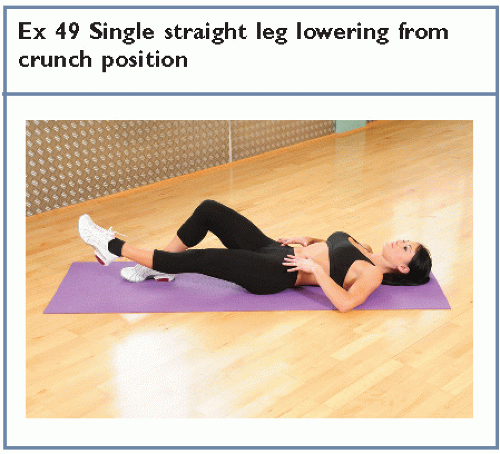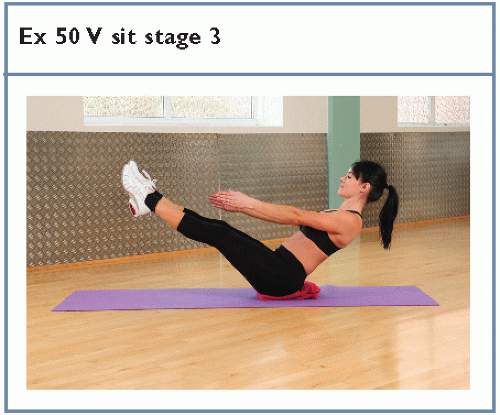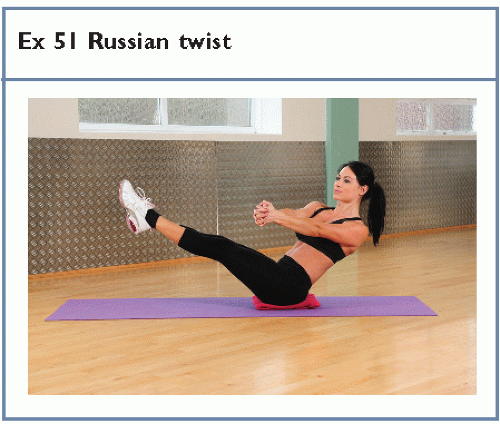Level Three
Up to this point we have used 48 abdominal training exercises. For the most part these are all that is required for everyday trunk fitness. For those who need greater levels of function we now look at level three exercises, which are harder still. Maintain good technique, however, paying particular attention to alignment and maintaining back stability.
Do not attempt this exercise until you can perform ten repetitions of exercise 38: single bent leg lowering from crunch position (page 119), maintaining a neutral position of the lumbar spine throughout the exercise.
Starting position
Lie on the floor with your knees bent and feet flat. Draw your right knee up above your hip, and straighten your left leg resting it on the floor.
Action
Tighten your tummy muscles to hollow your abdomen, and maintain this muscle contraction throughout the exercise. Keep your right (bent) leg still, and slowly lift and lower your left (straight) leg, maintaining the neutral position of your lumbar spine.
Points to note
Lifting the leg higher reduces the leverage effect of the straight leg and so makes the exercise easier from the point of the abdominal muscles.
Training tip
Monitor the position of your tummy and pelvis with your fingertips. If you feel your tummy bulging (‘ballooning’) rather than staying flat, or if you feel your pelvis move, stop the exercise.
Do not attempt this exercise until you can comfortably perform five repetitions with each leg of exercise 39: V sit stage 2 (page 120).
Starting position
Sit on the floor with your knees hip-width apart and bent, and feet flat (the crook or hook sitting position). Place your straight arms to the sides of your knees, palms facing inwards. Straighten your back, bracing your shoulders back slightly into the V sit position (exercise 31, page 111).
Action
Tighten your tummy muscles to hollow your abdomen slightly, and maintain this muscle contraction throughout the exercise. Straighten your right leg, keeping your left foot firmly on the floor. Hold the right leg straight and then straighten the left leg, pulling the legs together. Hold for 5 seconds and then lower.
Points to note
As you straighten your legs, maintain the hip angle so that the leg is held at 45 degrees to the mat. Lowering the legs towards the mat increases the leverage effect on the leg and makes the action considerably harder, placing excessive stress on the lumbar spine.
Training tip
There is often a tendency to bend (flex) the spine with this action. Try to maintain good spinal alignment throughout the exercise. A useful cue is to imagine a cord attached to your breastbone (sternum) pulling your chest forwards. In the end position, your straight legs and trunk should form a full ‘V’ shape. In yoga this exercise is called the boat pose (navasana).
Starting position
Lie on the floor and bend your knees. Lift your legs, keeping them bent, and keep your feet off the floor throughout the exercise. Sit up, with your hands together and your trunk off the ground forming a ‘V’ shape (see exercise 31, page 111).
Action
Reach your arms out straight, and twist your trunk to the left, then right, leading with your hands.
Points to note
You should remain balanced on your sitting bones (ishial tuberosities) and tailbone (coccyx) throughout the exercise.
Training tip
If you find the action too intense, allow your heels to just touch the floor as you twist your trunk.
Starting position
Lie on the floor and bend your knees, keeping your feet flat and shoulder-width apart. Sit up, holding a 5 kg weight disc at its edge.
Action
Reach your arms out straight, and twist your trunk to the left, and then right, leading with your hands.
Points to note
You should remain balanced on your sitting bones (ishial tuberosities) throughout the exercise, and your feet should stay on the mat.
Training tip
Choose a weight which suits your body size and strength. Make sure you perform the exercise correctly rather than using a weight which is too heavy – there is an old weight training adage ‘never sacrifice technique for weight!’
You must be able to perform 5-10 repetitions of exercise 40: pelvic raise 1, page 121, before attempting this exercise.














